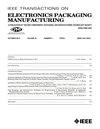Cross-Section Preparation for Solder Joints and MEMS Device Using Argon Ion Beam Milling
IEEE Transactions on Electronics Packaging Manufacturing
Pub Date : 2009-10-06
DOI:10.1109/TEPM.2009.2029344
引用次数: 17
Abstract
Mechanical cross-section polishing has traditionally been the method of choice for preparing samples to be examined by scanning electron microscopy (SEM). Although mechanical polishing, allied to selective chemical etching can reveal the most important characteristics of solder joint microstructure, subtle details may be lost. A relatively new cross section polishing method has been developed using an argon ion beam to prepare a flat surface with potentially less sample damage. In this study we compare these two methods of cross section polishing for solder-substrate couples, and for delicate MEMS type structures. Four solder samples were prepared, consisting of SAC (Sn-Ag-Cu) solder, SAC solder on copper substrate, SAC solder on nickel substrate and In-Sn solder on niobium substrate. SEM was used to examine the polished samples and it was found that features such as the internal structure of intermetallic compounds (IMCs) was more readily identified using the new technique. The ion beam milling technique was also found to be more suitable for simultaneous observation of multiple aspects of microstructure (e.g., identification of IMCs in relation to grain boundaries, substrate crystal structure or the eutectic solder structure). The MEMS device cross-sections could only be prepared by the ion beam method as mechanical polishing caused too much damage.利用氩离子束铣削制备焊点和MEMS器件的截面
传统上,机械截面抛光一直是制备扫描电子显微镜(SEM)检测样品的首选方法。虽然机械抛光与选择性化学蚀刻相结合可以揭示焊点微观结构的最重要特征,但可能会丢失微妙的细节。一种相对较新的横截面抛光方法是利用氩离子束来制备具有潜在较少样品损伤的平面。在本研究中,我们比较了这两种方法对焊料-衬底耦合和精密MEMS型结构的截面抛光。制备了4种钎料样品,分别为SAC (Sn-Ag-Cu)钎料、SAC基铜钎料、SAC基镍钎料和In-Sn基铌钎料。利用扫描电镜对抛光后的样品进行了分析,发现新技术更容易识别金属间化合物(IMCs)的内部结构。离子束铣削技术也被发现更适合于同时观察微观结构的多个方面(例如,识别与晶界、衬底晶体结构或共晶焊料结构相关的IMCs)。由于机械抛光造成的损伤太大,只能采用离子束方法制备MEMS器件截面。
本文章由计算机程序翻译,如有差异,请以英文原文为准。
求助全文
约1分钟内获得全文
求助全文

 求助内容:
求助内容: 应助结果提醒方式:
应助结果提醒方式:


